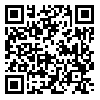Volume 28, Issue 3 (2021)
EIJH 2021, 28(3): 75-92 |
Back to browse issues page
Download citation:
BibTeX | RIS | EndNote | Medlars | ProCite | Reference Manager | RefWorks
Send citation to:



BibTeX | RIS | EndNote | Medlars | ProCite | Reference Manager | RefWorks
Send citation to:
Moradi A, Bakhtiari S, Bakhtiari S. Sacred Precincts of Buddhist Architecture in Northwest Iran. EIJH 2021; 28 (3) :75-92
URL: http://eijh.modares.ac.ir/article-27-33755-en.html
URL: http://eijh.modares.ac.ir/article-27-33755-en.html
1- Postdoctoral Researcher at the Otto-Friedrich University, Bamberg, Germany , aminmoradi66@yahoo.com
2- PhD in Archaeology, University of Mazandarn, Mazandaran, Iran
3- PhD in Archaeology, University of Sistan & Baluchestan, Zahedan, Iran.
2- PhD in Archaeology, University of Mazandarn, Mazandaran, Iran
3- PhD in Archaeology, University of Sistan & Baluchestan, Zahedan, Iran.
Abstract: (907 Views)
It is well documented that the Mongol rule in the thirteenth and fourteenth centuries fostered the direct exchange of ideas and practices between diverse cultures and religions. From this point of view, while the Mongols believed in shamanism, they embraced other religions for several reasons, ranging from a personal desire for the spiritual gains to issues of control and political and social cohesion. Hence, century of Mongol domination in Great Iran (1256-1353 CE) witnessed the practice of Buddhism, Manichaeism, Zoroastrianism, Judaism, Christianity, and Islam. While the importance of the Ilkhanid period for the architectural history of the Islamic World has generally been acknowledged, explanations for the appearance of rock-cut buildings in Iran under the Mongol dominion, in contrast with Islamic architecture, are not very satisfying. By focusing on field studies, the aim is to catalogue rock-cut architecture of Ilkhanid Iran with certain parallels with Buddhist architecture, isolate construction phases of monuments of this type in northwest Iran. According to the results, while an investigation of Buddhist architecture in northwest Iran would reveal a vibrant portrait of life in Ilkhanid Iran by illustrating how Ilkhanid architecture responds to various faiths and traditions, it would be possible to have a fresh look at the sociopolitical history of Islamic Iran in collision with the Mongol culture.
Article Type: Original Research |
Subject:
Arts and Humanities (General)
Received: 2019/06/11 | Accepted: 2021/05/28 | Published: 2021/07/19
Received: 2019/06/11 | Accepted: 2021/05/28 | Published: 2021/07/19
Send email to the article author
| Rights and permissions | |
 |
This work is licensed under a Creative Commons Attribution-NonCommercial 4.0 International License. |








